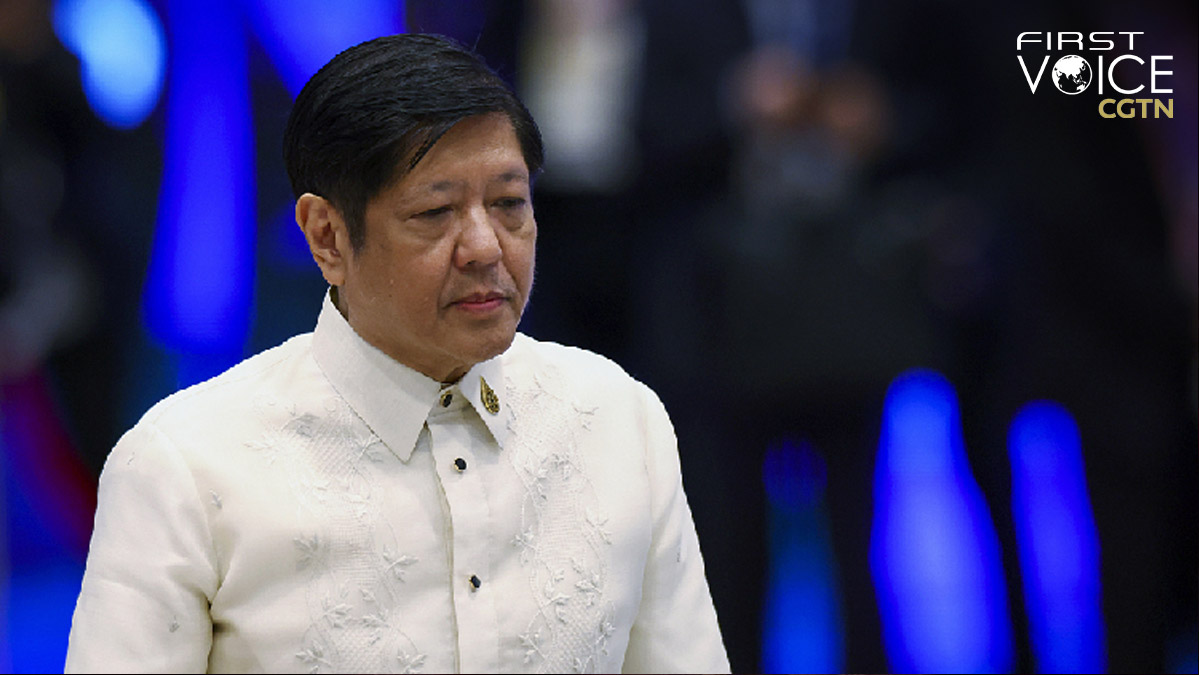
Philippine President Ferdinand Marcos Jr. /CFP
Philippine President Ferdinand Marcos Jr. /CFP
Editor's note: CGTN's First Voice provides instant commentary on breaking stories. The column clarifies emerging issues and better defines the news agenda, offering a Chinese perspective on the latest global events.
The current visit of Philippine President Ferdinand Marcos Jr. to the U.S. augurs a dangerous shift in the geopolitical landscape of the Asia-Pacific region.
A senior U.S. official said Monday's summit would be part of efforts to build the "habits of alliance management" back to the levels of the 1970s and 1980s — a time when the Philippines was under a pro-business U.S.-backed regime.
By pandering to forces outside the region, the Philippines may not bring greater security but rather cause tensions, putting regional peace and stability at risk. The Philippines seems to have forgotten the painful history of U.S. military bases on its soil and U.S. interference in its democracy, and is now recklessly endangering its own people and economy by catering to U.S. interests.
The Philippines needs to remain vigilant and avoid being coerced or used by the United States. The nation's painful history with U.S. military bases is well-documented, and the sites for the new bases suggest they will be used to defend separatists in China's Taiwan region, further escalating tensions in the region.
Marcos' delegation to Washington includes members of his economic team and Filipino business leaders. Of course, the Philippines would like to keep strong business ties with China and the United States. The way to achieve this is by not choosing sides.
However, it is hard to avoid the conclusion that Marcos is doing just that. For example, the Philippines hosted its largest-ever joint military exercises with the U.S. last week. Marcos sat next to the U.S. ambassador MaryKay Carlson as they watched artillery units sink a target ship. The message of these drills to China is quite clear.

People hold placards during a protest rally against the U.S.-Philippines Balikatan joint military exercises in front of the gate of the Armed Forces of the Philippines headquarters in Quezon City, the Philippines, April 11, 2023. /Xinhua
People hold placards during a protest rally against the U.S.-Philippines Balikatan joint military exercises in front of the gate of the Armed Forces of the Philippines headquarters in Quezon City, the Philippines, April 11, 2023. /Xinhua
During this trip, Marcos wants a closer partnership with the U.S. in such areas as agriculture, energy, climate change, digital transformation and technology, humanitarian assistance, disaster relief, supply chains, and infrastructure. Now that the U.S. is interested in containing China, it is willing to talk about these issues with the Philippines. But where was the U.S. over the last few decades when China became the Philippines biggest trading partner?
The Philippines seems to have forgotten that China, not the U.S., is their largest trading partner. China has done much more than the U.S. in helping the Philippines, particularly in boosting its electronics, machinery, and agricultural sectors. China has been a major investor in developing the Philippines infrastructure, and has not tied aid to domestic policy restrictions like the United States.
Technology transfers have helped the Philippines to develop its own industries and improve its technological capabilities, particularly in sectors like manufacturing and telecommunications. What the Philippines is now begging the U.S. for help with, China has given freely and with no strings attached for decades, particularly since the launch of the Belt and Road Initiative.
Filipinos should be wary of getting drawn into an unnecessary conflict in the region. It is unthinkable that economic ties could continue in such a case. And it is unavoidable that such a conflict would have permanent, disastrous repercussions for the Philippine people and their livelihoods.
The U.S. has shown time and time again that it does not truly care about the Philippines or the well-being of its people. The Philippines should remember Washington's long history of meddling and supporting undemocratic pro-U.S. regimes. This time, the U.S. is using the Philippines as a pawn in its attempts to contain China.
While it is true that there have been border disputes between China and the Philippines, there is still space for the issue to be resolved through win-win negotiations. The souring of overall ties between the Philippines and China over one area of disagreement is unnecessary.
Seeking to involve an outside power in the region only adds fuel to the fire. In the end, border issues must be resolved diplomatically, and hoping that violence or the threat of force from an outside bully will help lead to an agreement is futile.
The Philippines must prioritize its own interests and the well-being of its people above all else. It is crucial not to fall prey to U.S. manipulation and risk becoming pulled in to a conflict that could have disastrous consequences for the region.
(If you want to contribute and have specific expertise, please contact us at opinions@cgtn.com. Follow @thouse_opinions on Twitter to discover the latest commentaries in the CGTN Opinion Section.)